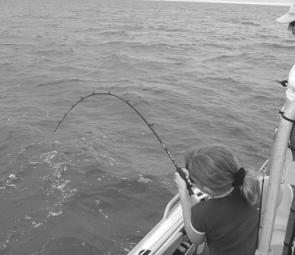The wet is all but gone. The water is clear on the doubles. Lots of pelagic activity as the bait gathers up on the inshore sandbanks and gutters. It’s fingermark time.
The fingermark (Lutjanus johnii) – also known as spotted-scale sea perch, chopper bream, red bream, Cape reddy and golden snapper – is one of our finest sporting and tablefish here in the Gulf.
April is when big fingermark arrive in the Gulf to haunt the average grunter fishermen, and the fingermark at Karumba certainly grow to bragging size. An 8-9kg fingermark is a great looking fish – solid across the shoulders with a big paddle tail and thick tail wrist. They’re built for short powerful bursts, and any structure that a larger fish can find will end the show for the tired angler in the boat.
Larger fingermark traditionally like deep offshore waters where there is reef or rocks. Headlands are a good place to start looking on the East Coast. However, in Karumba fingermark will hover near anything that isn’t sand or mud. Any gravel or a shelly bottom found offshore is a good start. Tiny specimens, some only 15-20cm, will often attack baits meant for bigger brothers.
The more average size fish can turn up anywhere. They can be found offshore, in the mouths of rivers in the deeper holes or upstream on brackish water rockbars. Later in the year they are a real lure possibility in the upstream reaches of tidal creeks.
Fishermen soaking a bit of squid or mullet around Karumba catch plenty of fingermark accidentally. If you’re using squid or mullet fillet make sure that the end above the hook eye is secured with a half hitch so the bait stays nice and long on the hook and doesn’t bunch up. Keep your bait moving by gently jigging it.
If you’re targeting fingermark take the time to catch some good live mullet and find some good bottom to fish. Once you find the fish it won’t take long for the mayhem to begin. Dropping livies back to structure like channel markers is also a good way to target them, however be prepared to use plenty of drag to keep your chances as high as possible. These fish are dirty fighters.
While deadbait and livebait fishing is an effective way to chase fingermark, lurefishing is by far the most challenging. Fingermark slam lures like mangrove jacks. When they’re pumped up, the risk of losing a feed to one of their brothers will bring out their competitiveness. There are plenty of chances for repeated hook-ups with several fish fighting for the next lure.
Trolling deep diving lures along the Channel Edge at Karumba is a great way to lure these fish. Work in close to the channel markers and hang on. Once a school of fish is located pull up and drop some jigs like Halco Tremblers or a big Prawnstar. You will appreciate the fish a lot more if you fool one into taking a jig. Soft plastics are also a great way to hook these fish but the dental qualifications make short work of most soft lures.
And for those who like to flyfish, a fingermark caught on fly is fantastic.
Fingermark is always welcome at our house and is rated higher then grunter and barramundi. Those 3-4kg fish are by far the best for eating as the larger specimens can either be OK or tough as old boots. At around 8-10kg they seem to have reached their growth potential and could be 5-30 years old. Don’t take the chance and release all the big ones.
How is it possible that Mekong Delta catfish can be imported into Australia and then sold as a ‘fish BASA’ (usually called ‘fish of the day’) in restaurants and fish and chip shops? When Today Tonight exposed this sham recently people were horrified about what they had been eating.
Australia has such stringent conditions for exporting food, so how does this foul imported fish end up on our plates? Keep that in mind the next time you order some fish.
Reads: 6589
Fingermark can be found offshore around Karumba but be prepared for a battle. They’re dirty fighters.

Fingermark is a prized tablefish in my house, and it’s even better when the kids do all the work catching dinner!




